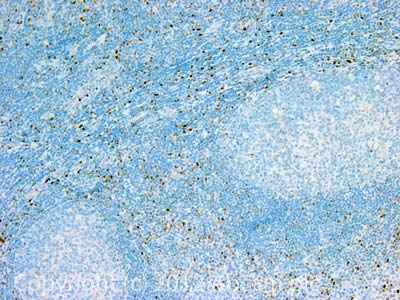Anti-T-bet / Tbx21 antibody [4B10]
| Name | Anti-T-bet / Tbx21 antibody [4B10] |
|---|---|
| Supplier | Abcam |
| Catalog | ab91109 |
| Prices | $398.00 |
| Sizes | 100 µg |
| Host | Mouse |
| Clonality | Monoclonal |
| Isotype | IgG1 |
| Clone | 4B10 |
| Applications | IHC-P WB IP FC |
| Species Reactivities | Mouse, Human |
| Antigen | E |
| Description | Mouse Monoclonal |
| Gene | TBX21 |
| Conjugate | Unconjugated |
| Supplier Page | Shop |
Product images
Product References
TIR-domain-containing adapter-inducing interferon-beta (TRIF) regulates - TIR-domain-containing adapter-inducing interferon-beta (TRIF) regulates
Kanagavelu S, Flores C, Termini JM, Riveron R, Romero L, Chung K, Ruiz J, Hyun J, Yuan X, Dagvadorj J, Fukata M. Mucosal Immunol. 2015 Mar;8(2):296-306.
.
Development- and activity-dependent expression of clusterin in the mouse - Development- and activity-dependent expression of clusterin in the mouse
Wu RQ, Xu ZX, Rao XP, Xu FQ. Int J Dev Neurosci. 2013 Nov;31(7):550-9.
Adiponectin induces pro-inflammatory programs in human macrophages and CD4+ T - Adiponectin induces pro-inflammatory programs in human macrophages and CD4+ T
Cheng X, Folco EJ, Shimizu K, Libby P. J Biol Chem. 2012 Oct 26;287(44):36896-904.
A novel transcription factor, T-bet, directs Th1 lineage commitment. - A novel transcription factor, T-bet, directs Th1 lineage commitment.
Szabo SJ, Kim ST, Costa GL, Zhang X, Fathman CG, Glimcher LH. Cell. 2000 Mar 17;100(6):655-69.
![Overlay histogram showing Jurkat cells stained with ab91109 (red line). The cells were fixed with 4% paraformaldehyde (10 min) and then permeabilized with 0.1% PBS-Tween for 20 min. The cells were then incubated in 1x PBS / 10% normal goat serum / 0.3M glycine to block non-specific protein-protein interactions followed by the antibody (ab91109, 2µg/1x106 cells) for 30 min at 22ºC. The secondary antibody used was DyLight® 488 goat anti-mouse IgG (H+L) (ab96879) at 1/500 dilution for 30 min at 22ºC. Isotype control antibody (black line) was mouse IgG1 [ICIGG1] (ab91353, 2µg/1x106 cells) used under the same conditions. Acquisition of >5,000 events was performed. This antibody gave a positive signal in Jurkat cells fixed with 80% methanol (5 min)/permeabilized with 0.1% PBS-Tween for 20 min used under the same conditions.](http://www.bioprodhub.com/system/product_images/ab_products/2/sub_5/7927_T-bet-Tbx21-Primary-antibodies-ab91109-6.jpg)
